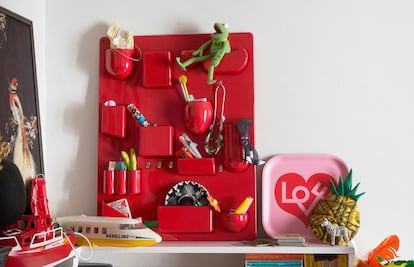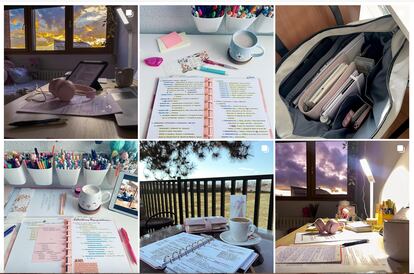From Mariana Enriquez’s chaos to the perfect workspace: What the disorder of our work desk says about us
Some studies suggest that remote workers spend up to 13 hours a day anchored to this piece of furniture where they have all kinds of habits, manias and superstitions

According to the myth informed by pictures of the workstations of Gay Talese, Marguerite Duras and Javier Marías, a veteran writer’s office is overflowing with files and folders, old editions of classic works, talismans and exotic souvenirs, handwritten letters and signed photographs. But in fact this workplace has more in common with the LED-filled setup (the table, chair, computer, controls and cameras) of a streamer than one might think.
First, both are the same kind of space: workplaces where — the legend goes — the solitary creator with hours to spare can feel free to unleash their genius, or else be overwhelmed by deadlines, with household chores piling up nearby and all the difficulties and inconveniences of fast-paced remote working. Secondly, both the writer and the streamer will find themselves surrounded by very different objects if they are working, but they are almost always in front of a screen. And if philosopher Gaston Bachelard wrote in 1961 that the true space of solitary work in a small room is the circle illuminated by the lamp, today that lamp has been transformed into a screen that emits bluish light onto our tired faces, as in Bianca Baganarelli’s illustration for this year’s January edition of The New Yorker.
Ergonomics vs. decoration: We are the objects that surround us
In 1969, Dorothee Becker designed Uten.Silo, a milestone in the organization of domestic spaces that has been widely imitated; the original version is marketed by Vitra. Thanks to a panel on which everyday objects are placed like tools in a machine shop, she freed up space in desks and drawers and built a bridge between the world of work and our bedrooms. Becker’s panel is designed to hold everything (writing utensils, cables, paper notes...) that creates a sense of clutter on a table; along with the Arik Levy Toolbox (this name identifies the desk and the workshop), it allows for the organization of small objects.
Efforts to create more pleasant and ergonomic workspaces in our homes are a serious matter. Some studies suggest that remote workers spend up to 13 hours a day in front of a screen, i.e., anchored to their desk. Thus, the desktop is a tiny territory in an increasingly virtual and therefore deterritorialized world. It’s the non-transferable kingdom of a single inhabitant (sovereign and slave at once) who will exercise all kinds of habits, manias and superstitions on it. The desktop has also become the cockpit of the bathyscaphe with which we dive into the internet.
If the monitor is the porthole through which we observe the virtual universe, around it, we also have provisions (a coffee or an energy drink that will leave a ring of humidity) and amulets (the portrait of a relative or a cherished miniature) to which we can turn when we find something terrifying among the pixels. Finally, the desk imposes postures, has a certain texture, and reminds us, with its sharp edges imprinted on our forearms, that it doesn’t matter how much time we spend on the internet because we are still (connected) bodies.

While surfing the internet is a new experience, the importance of workspaces dates back centuries. In 1794, for example, French aristocrat Xavier de Maistre published an essay called A Journey Around My Room. After participating in an illegal duel, de Maistre was sentenced to a 42-day confinement, which he spent writing and touring “the enchanting country of the imagination.” So, if literature is inseparable from the desks where it unfolds, it is also inseparable from the journeys that inspire it. After all, our culture’s founding stories feature travelers and navigators (Ulysses and Aeneas); perhaps that is why globes and to-scale sailing ships are the most frequent decorations on fiction writers’ desks, as can be seen in Proyecto Escritorio. La escritura y sus espacios (Project Desk: Writing and Its Spaces), edited by Jesús Ortega. In the book you can also see very chaotic desks: For example, Argentine writer Mariana Enríquez says that her “mess is atrocious and I should clear it up” but she cannot solve it “because her writing is also messy” while Spanish writer Felipe Benítez Reyes’s desk is full of exotic objects that serve as a parapet in something of a room of wonders.
But there are professionals who have less cluttered desks. Indeed, sharing photos of your workspace became a popular trend on social media and forums. This was the case of the hashtag #opozulo [perfect work or study space], with which a person tags photos of the places where they study, or the successful “Show your work/leisure space” threads on the Spanish website Forocoches. In these posts, we can once again sense the tension between order (which imposes all kinds of elements to organize cables or papers at different levels) and anarchy.

From the dressing table to the desk: The places where we construct ourselves
The light from screens illuminates us in the same way the lightbulbs on a mirror used to do. That is what architect Rosana Galián suggests; she compares the desk to the dressing table, a piece of furniture dedicated to the construction of one’s image and, singularly, of feminine beauty.
Galián, of Garra Studio, explains that, like so many contemporary professionals, she bases how she works, and therefore, her desk and her daily context, on that Eames’ phrase (the married architect couple who revolutionized and made American interior design more flexible): “Work is life, life is work.” The architect and designer says that “our physical workplace, our desk, overlaps with our leisure and our desires. We can’t find a way to separate some things from others, so our intellectual or professional construction is absolutely linked to our construction as women, to our construction of beauty and even to our construction of gender and eroticization. A working person’s desk is a desk of emancipation in all senses, not just the professional.”
A proponent of the intimate and apparently confusing desk, Galián says that when she has designed offices she has not found much understanding: “They opt for more corporate constructions that move away from the real work desk, which is more personal and allows for tapping into creativity.” She concludes: “The desk has room for tools, personal objects and, above all, modes of connection. We do not work from a hermetic position, but rather we open ourselves to space and hyper-identity. The desk is a connected, baroque and messy space.”
Sign up for our weekly newsletter to get more English-language news coverage from EL PAÍS USA Edition
Tu suscripción se está usando en otro dispositivo
¿Quieres añadir otro usuario a tu suscripción?
Si continúas leyendo en este dispositivo, no se podrá leer en el otro.
FlechaTu suscripción se está usando en otro dispositivo y solo puedes acceder a EL PAÍS desde un dispositivo a la vez.
Si quieres compartir tu cuenta, cambia tu suscripción a la modalidad Premium, así podrás añadir otro usuario. Cada uno accederá con su propia cuenta de email, lo que os permitirá personalizar vuestra experiencia en EL PAÍS.
¿Tienes una suscripción de empresa? Accede aquí para contratar más cuentas.
En el caso de no saber quién está usando tu cuenta, te recomendamos cambiar tu contraseña aquí.
Si decides continuar compartiendo tu cuenta, este mensaje se mostrará en tu dispositivo y en el de la otra persona que está usando tu cuenta de forma indefinida, afectando a tu experiencia de lectura. Puedes consultar aquí los términos y condiciones de la suscripción digital.
More information
Archived In
Últimas noticias
Christmas loses its festive spirit: ICE fears cast shadow over religious celebrations
All the effects of gentrification in one corner of Mexico’s Colonia Roma
Palestinian reporter Youmna El Sayed: ‘My family told me I had to choose between being a journalist or a mother’
The new language of the workplace: Knowing how to ask AI questions is more important than using it
Most viewed
- The low-cost creative revolution: How technology is making art accessible to everyone
- Christian Louboutin: ‘Young people don’t want to be like their parents. And if their parents wear sneakers, they’re going to look for something else’
- US sanctions against jailed cartel leader ‘El Marro’ highlight Mexico’s lack of control over its prisons
- Liset Menéndez de la Prida, neuroscientist: ‘It’s not normal to constantly seek pleasure; it’s important to be bored, to be calm’
- Cartels in Mexico take a leap forward with narco-drones: ‘It is criminal groups that are leading the innovation race’










































